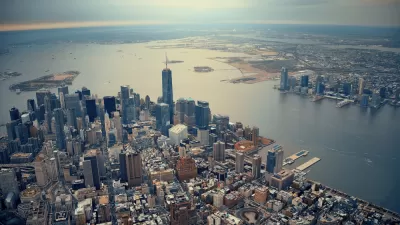A new report focusing on design professionals and architects in New York finds that these industries are on a strong growth path and create a significant impact on the local economy.
Urban Omnibus talks with the lead author of the report, which is titled Growth by Design.
"Urban Omnibus: For those who haven't read the report in full, please summarize your key findings.
David Giles, The Center for an Urban Future: We established beyond all doubt that New York City's design industries, including architecture, are not only an important part of the city's economy but one that has been growing rapidly over the last decade and will likely continue to grow. Despite the 2008 crash and the depressed economy that followed, the number of design firms in the city rose 15 percent since 2001, which is a much faster rate of growth than most other industries. New York has 3,969 firms in architecture, landscape architecture, fashion, graphic design, industrial design, and interior design. That's 33 percent more design firms than Los Angeles, the next largest city. The New York metro area has 40,470 designers, a majority of whom don't work at design firms, and that's 75 percent more than the next largest city which, again, is Los Angeles (with 23,160 designers).
When you look at the proportion of employed people in New York who work as designers, you'll see the city has a much higher concentration of designers than any other major U.S. city with the exception of San Francisco, which has an equivalent concentration but a smaller number. Economists measure an industry's geographic concentration in order to get a sense of how much it is exporting to other places; if the concentration is much above the national average, then it is likely serving more than just local needs. New York's design cluster is well-above the national average. That's a good sign."
FULL STORY: Growth by Design

Pennsylvania Mall Conversion Bill Passes House
If passed, the bill would promote the adaptive reuse of defunct commercial buildings.

Coming Soon to Ohio: The Largest Agrivoltaic Farm in the US
The ambitious 6,000-acre project will combine an 800-watt solar farm with crop and livestock production.

World's Largest Wildlife Overpass In the Works in Los Angeles County
Caltrans will soon close half of the 101 Freeway in order to continue construction of the Wallis Annenberg Wildlife Crossing near Agoura Hills in Los Angeles County.

California Grid Runs on 100% Renewable Energy for Over 9 Hours
The state’s energy grid was entirely powered by clean energy for some portion of the day on 37 out of the last 45 days.

New Forecasting Tool Aims to Reduce Heat-Related Deaths
Two federal agencies launched a new, easy-to-use, color-coded heat warning system that combines meteorological and medical risk factors.

AI Traffic Management Comes to Dallas-Fort Worth
Several Texas cities are using an AI-powered platform called NoTraffic to help manage traffic signals to increase safety and improve traffic flow.
City of Costa Mesa
Licking County
Barrett Planning Group LLC
HUD's Office of Policy Development and Research
Mpact Transit + Community
HUD's Office of Policy Development and Research
Tufts University, Department of Urban and Environmental Policy & Planning
City of Universal City TX
ULI Northwest Arkansas
Urban Design for Planners 1: Software Tools
This six-course series explores essential urban design concepts using open source software and equips planners with the tools they need to participate fully in the urban design process.
Planning for Universal Design
Learn the tools for implementing Universal Design in planning regulations.


























